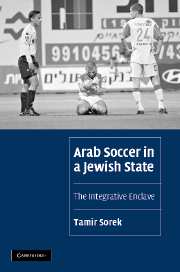Book contents
- Frontmatter
- Contents
- List of tables
- List of figures
- Preface and acknowledgments
- 1 Introduction
- 2 Sports, modernity, and struggle in Palestine
- 3 The emergence of the integrative enclave
- 4 Soccer and municipal “labor quiet”
- 5 “These points are Arab”: nationalist rhetoric in the sports press
- 6 “Maccabi Haifa is my flag”: Arab fans of Jewish teams
- 7 The Islamic Soccer League
- 8 Sakhnin – between soccer and martyrdom
- 9 Conclusion
- Appendix 1 Interviews with functionaries
- Appendix 2 Research design of the countrywide survey
- Appendix 3 Main findings from the countrywide survey
- Appendix 4 Research design of the survey in Sakhnin
- Appendix 5 Explanations for chapter 4
- Bibliography
- Index
- Cambridge Cultural Social Studies
Appendix 2 - Research design of the countrywide survey
Published online by Cambridge University Press: 22 September 2009
- Frontmatter
- Contents
- List of tables
- List of figures
- Preface and acknowledgments
- 1 Introduction
- 2 Sports, modernity, and struggle in Palestine
- 3 The emergence of the integrative enclave
- 4 Soccer and municipal “labor quiet”
- 5 “These points are Arab”: nationalist rhetoric in the sports press
- 6 “Maccabi Haifa is my flag”: Arab fans of Jewish teams
- 7 The Islamic Soccer League
- 8 Sakhnin – between soccer and martyrdom
- 9 Conclusion
- Appendix 1 Interviews with functionaries
- Appendix 2 Research design of the countrywide survey
- Appendix 3 Main findings from the countrywide survey
- Appendix 4 Research design of the survey in Sakhnin
- Appendix 5 Explanations for chapter 4
- Bibliography
- Index
- Cambridge Cultural Social Studies
Summary
Interviewees: 448 Arab men aged 18–50 who constitute a representative sample of this sub-population. The choice to interview only men aimed at ensuring an optimal variance in the independent variables (involvement in soccer) since preliminary fieldwork showed that the presence of Arab women in soccer stadiums is extremely rare. This is also the reason that the maximum age was restricted to 50. The interviews took place in January 2000 in the interviewees' homes.
Sampling: The interviewees were sampled by a two-step sampling. First, statistical areas (SA) were sampled by a proportional layer sampling. The sampling pool included statistical areas that contained at least 5,000 residents in a 1995 census held by the Israeli Central Bureau of Statistics, and statistical areas that contained at least 1,000 residents in localities that included more than one statistical area. The sampling was based on two dimensions: geographical area (the Galilee, the Triangle, the Negev), and education level, measured by the percentage of high-school graduate certificate-holders within the adult population in each area. The areas were distributed according to three educational categories, each one of them consisting of one-third of the areas: Low – less than 30 percent of high-school graduate certificate-holders; Medium – between 30 and 40 percent; and High – above 40 percent. According to these two dimensions a theoretical table of nine categories was composed. Practically, 141 of the 142 areas that were included in the sample were aggregated into seven categories; 15 percent of the SA were sampled from each category.
- Type
- Chapter
- Information
- Arab Soccer in a Jewish StateThe Integrative Enclave, pp. 194 - 196Publisher: Cambridge University PressPrint publication year: 2007

